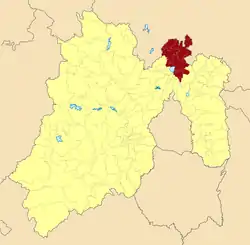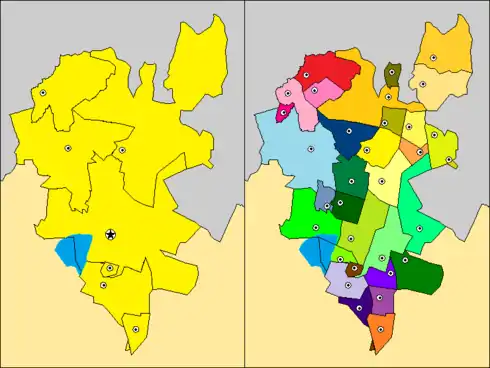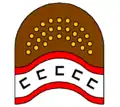Zumpango Region
Zumpango is a region, located in the north of the State of Mexico in the country of the same name. It is also known as the Region XVI Zumpango and has seen major population growth. It has a surface area of 8.305 km² and occupies 12.8% of the state's territory. The seat of Zumpango Region is Zumpango de Ocampo city.

The region is dominated by a dry and moderate sub-humid climates and the reliefs fence with lomerios that part with the Eje Neovolcánico located at a northern pass leading out of the Valley of Mexico and Mezquital Valley , this territory was located inside old Aztec region named the Teotlalpan.
Agricultural production is very important to the region, and ranching and craftwork are also part of its development. This region is named by the people as Zumpangolandia.
History
Archaeology
In May 2020, discovery of remains of at least sixty mammoths (included male, famele, young mammoths) and 15 people were uncovered by the National Institute of Anthropology and History headed by archaeologist Sánchez Nava under the Mexico City Santa-Lucia airport, in the former Lake Xaltocan. According to the INAH, mammoth skeletons revealed in what used to be the shallow part of the lake were better anatomically preserved than those found in the deeper parts of the former lake. Mammoths probably got stuck in the lake and died.[1][2][3][4]
Geography
The location of the region is in the north of the state of Mexico, and is located in the low extreme geographical coordinates of Greenwich, north latitude 19º50'23" minimum, 19º58'28" maximum, west longitude 99°04'30" minimum, 99°13'35" maximum.[5]
The town of Zumpango de Ocampo, a municipal seat, has governing jurisdiction over the following municipalities: Apaxco, Hueypoxtla, Jaltenco, Nextlalpan, Tequixquiac,Tonanitla and Zumpango.[6] The total region extends 96.37 and borders the regions of Ecatepec Region, Hueypoxtla, Tultitlán Region and the state of Hidalgo.
Hydrography
The Gran Canal de Desagüe is an artificial channel that crossing Tequixquiac, was named Xothé river in Otomi language, this channel connect with Tula river and Enthó dam. Other small rivers are Río Salado of Hueypoxtla, Treviño river and La Pila river, which connect with Gran Canal.[5]
The municipal seat is in a small, elongated valley but most of the municipality is on a high mesa which transitions from the Valley of Mexico to the Mezquital Valley.[7] The highest mountain in Tequixquiac is the Cerro Mesa Ahumada, it rises 2,600 metres (8,500 ft) above sea level,[8] on the border between the municipalities of Huehuetoca and Apaxco.
| Municipality | Area (km²) 2010[9] | Population 2005 Census | Population 2010 Census | Population density (/km² 2010) |
|---|---|---|---|---|
| Apaxco | 80.34 | 25,738 | 27,521 | 42.1 |
| Hueypoxtla | 246.95 | 36,512 | 39,864 | 39.6 |
| Jaltenco | 3.30 | 26,359 | 26,328 | 113.7 |
| Nextlalpan | 42.49 | 22,507 | 34,374 | 41.3 |
| Tequixquiac | 96.37 | 28,039 | 33,907 | 82.04 |
| Tonanitla | 17.10 | 8,081 | 10,216 | 41.3 |
| Zumpango | 244.08 | 127,988 | 159,647 | 41.3 |
| Region XVI Zumpango | 2795.1 | 275,224 | 331,857 | 56.5 |
Region municipalities
Government
Deputation
| Local mayor | Time |
|---|---|
| 2006-2009 | |
| 2009-2012 | |
| 2013-2015 | |
| 2015-2018 | |
Subdivition of Zumpango Region

- Santa María Apaxco
- Apaxco de Ocampo
- Pérez de Galeana
- Coyotillos
- Casa Blanca
- Hueypoxtla
- Guadalupe Nopala
- San José Bata (Emiliano Zapata)
- San Francisco Zacacalco
- San Pedro la Gloria
- San Marcos Jilotzingo
- Santa María Ajoloapan
- Tezontlalpan de Zapata
- Tianguistongo
- Rancho el Carmen
- Alborada Jaltenco
- San Andrés Jaltenco
- Santa Ana Nextlalpan
- San Miguel Xaltocán
- Santa Inés
- Santa María Tonanitla
- Santiago Tequixquiac
- Tlapanaloya
- Colonia Wenceslao Labra
- Zumpango de Ocampo
References
- David Williams. "Archaeologists found the bones of about 60 mammoths at an airport construction site". CNN. Retrieved 2020-09-08.
- City, Associated Press in Mexico (2020-05-22). "'There are too many': bones of 60 mammoths found in Mexico". the Guardian. Retrieved 2020-09-08.
- "Bones of about 60 mammoths found near ancient lake in Mexico". www.cbsnews.com. Retrieved 2020-09-08.
- "A mammoth discovery: Giant remains found near Mexico City". www.aljazeera.com. Retrieved 2020-09-08.
- Tequixquiac municipality INEGI, 2009.
- EDOMEX. "Link to tables of population data from Census of 2010". Archived from the original on 2013-02-27. Retrieved 2008-10-25.
- "Tula de Allende". Enciclopedia de los municipios y delegaciones de México Estado de Hidalgo (in Spanish). Mexico: INFED. Archived from the original on June 2, 2013. Retrieved February 7, 2013.
- Piña, Ma. Guadalupe Arzate, Ma. Soledad Martínez. "Catálogo Localidades". www.microrregiones.gob.mx.






